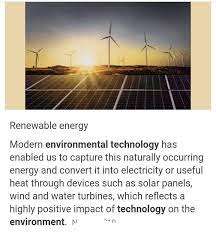Innovative science such as synthetic biology, precision health and new energy technologies have tremendous societal potential. But they are also “two-edged swords” in their environmental impacts. Innovative Technology and Environmental Consequences
New economic approaches to environmental management can blunt their destructive edge and hone their capacity for good. For example, tradable pollution permits encourage firms to develop cleaner production processes.

1. Innovative Technology
A major driver of the global economy is innovation, and we are certainly in an era of unprecedented technological advancement. However, as new technologies come on the market, they have a profound impact on our environment.
A great example is renewable energy, which uses solar, wind, tides, and waves to generate electricity or useful heat. This technology has a positive environmental impact and can be used in many ways to reduce our carbon footprint.
Other examples of innovative technology include faster internet and streaming media, which eliminates the need for CDs and DVDs and their wasteful packaging. Smart technology also puts a stop to food waste, while carbon capture and storage (CCS) can eliminate one of the largest contributing factors to climate change.
Economic analysis of environmental policy has often neglected the positive externalities of these technologies. However, with the time lags involved in innovation, it may be necessary to support the development of cleaner technologies to augment the’standard’ instruments of environmental policy.
2. Environmental Consequences
While some technological decisions put environmental and economic needs in competition with each other, others can have positive effects for both. Reusing and recycling can reduce waste and thereby prevent the need for new materials, and some technologies can help us monitor environmental changes over time.
The use of communication technologies to enable people to work from home, for example, reduces the demand for gasoline and other forms of transportation. Computer models can optimize industrial processes to conserve energy and reduce waste, as well. Alternative energy sources such as wind power also have potential to reduce dependence on fossil fuels.
Environmental technology may have negative consequences, as well. For example, emissions from industrial and vehicular activities pollute air quality and contribute to global climate change. Likewise, the deposition of nitrogen oxides from agricultural runoff promotes excessive growth of algae in lakes, rivers and estuaries, leading to eutrophic conditions that kill submerged vegetation. Getting prices right, through such tools as tradable pollution permits, can encourage innovation in ways to reduce these pollutants.
3. Economic Consequences
Technological innovation is a crucial economic function, recognizing new technological possibilities, organizing the human and financial resources needed to transform them into useful products and processes and sustaining these activities. It has played a key role in facilitating radically improved standards of living.
However, the benefits of innovations are usually realized only when they have spread throughout the economy. For example, energy efficiency technology lowers the amount of fossil fuels used or the number of GHG emissions per unit of useful product (such as a car-mile or lumen of illumination).
Government policies can encourage or inhibit technological innovation. They can include incentives, such as tax credits or subsidies, and can include requirements, such as environmental and energy standards. Different policy options influence innovation in different ways.
4. Social Consequences
However, some social consequences are also significant, such as environmental degradation and growing inequality within a society.
Government actions can also help to create sizeable markets for technologies that reduce GHG emissions needs read more hear.


























